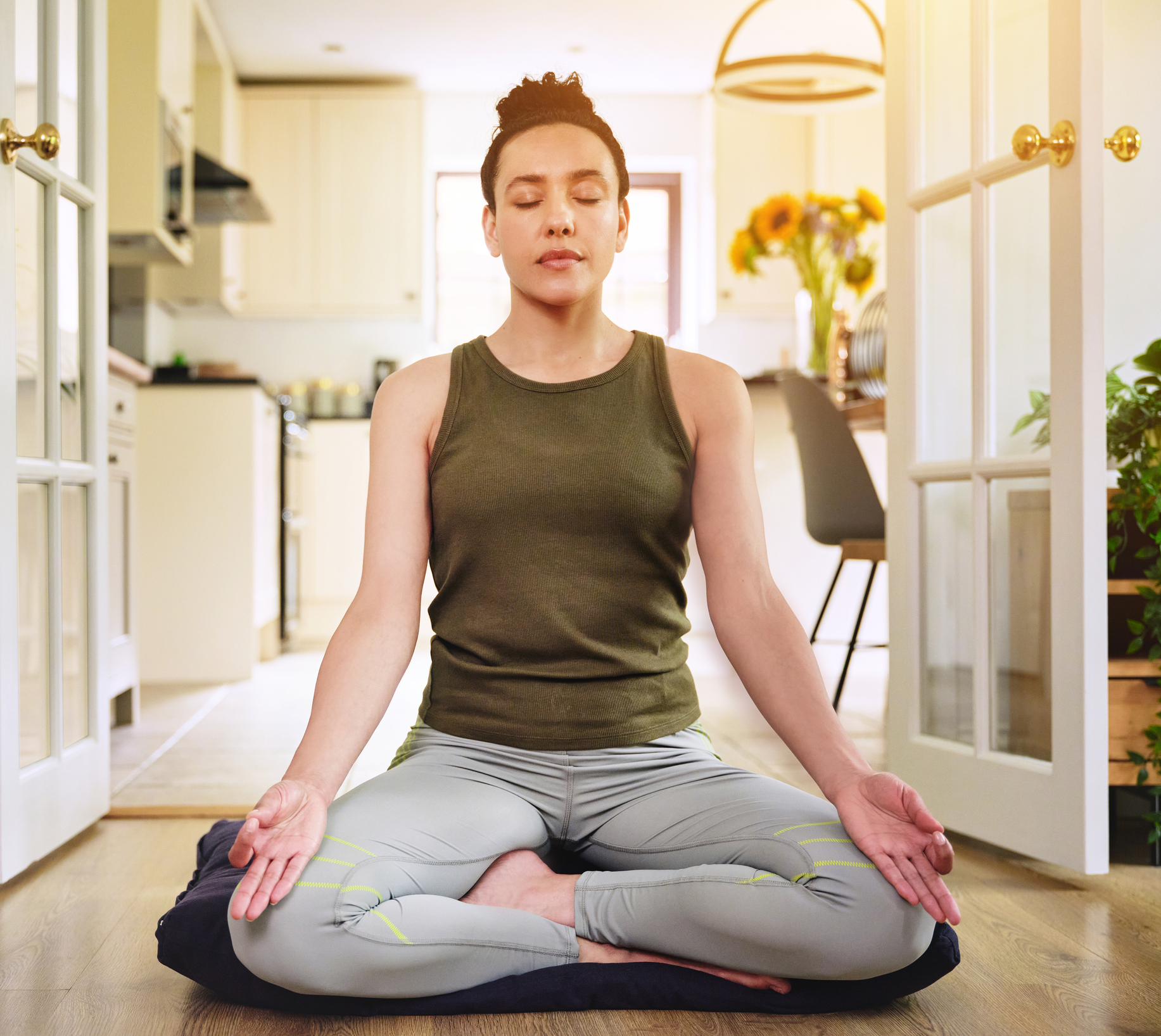After practicing meditation regularly for some time, you will be able to enter a meditative state at will with minimum or no preparation. However, as you begin to develop your practice these guidelines will enhance your experience of meditation. They establish an inner and outer environment conducive to meditation by reducing 2 of the biggest distractions people face when starting a meditation practice – discomfort in the physical body and mental chatter. You can enhance your meditation practice by following these suggestions.
“Your mind is a sky. Thoughts are clouds passing by. In meditation, don’t try to clear the sky, just be the sky.”
Your Meditation Space
The ideal place and way to practice seated meditation has the following characteristics:
- It is comfortable and uncluttered
- Fresh air circulates
- It is quiet. Conversations, the sound of the TV, and other noises stimulate the senses and draw your awareness away from your point of focus
- You will not be interrupted. Once the mind is steady and focused, any interruption will most likely require you to begin again with calming the mind.
- Practice at the same time and in the same place. This allows positive energy from your meditation practice to accumulate and also will subconsciously trigger the body and mind to settle for meditation.
- Practice when your stomach is not full. This makes it easier not to fall asleep during practice.
- Practice when you are not sleepy – or you will most assuredly doze off during your practice!
However, in real life “ideal” is not always possible. And that’s ok. Just incorporate as many of the above guidelines to prepare for meditation. And if none of them are within reach, that’s okay too. Just practice in any way you can manage! You will still benefit. If you need more specific guidance on how to prepare for meditation at home, let me know.
Release Physical Tension from the Body and Mind
Stressors are an inherent part of daily life. Running late for an appointment, inadequate preparation for an exam, receiving disappointing news, an unpleasant interaction with someone are all potential stressors. We automatically create tension in the body and mind in response. Tension in the body causes physical discomfort and tension in the mind causes excess mental chatter. These tensions remain until we actively release them through some form of movement, relaxation, or body-based therapy.
Stored tension in the body and mind can create discomfort that becomes more noticeable when attempting to become still as we do in meditation. As a result, awareness will shift from your point of focus and your mind will become preoccupied with its own chattering or the discomfort you feel. For this reason, releasing tension from the body and mind before your meditation practice is important.
Minimize the chance of physical discomfort during meditation by starting with gentle physical exercise. If you have warm-up exercises or gentle stretches that your normally do, you can use these. You can also simply stretch and move your body in whatever way feels comfortable to you. If you’re not sure what to do, here are a few ideas.
Gentle Exercise for the Body
– Palm Tree Pose
This is a balancing whole body stretch. Practice with the eyes open and focused at a point on the floor or on the wall at eye height.
-
-
- Stand with spine erect, crown of head rising up towards ceiling.
- Interlace fingers and place hands on the crown of the head with the palms facing up.
- Inhale as you stretch your arms above head reaching towards ceiling with the palms while coming up on the toes.
- Exhale and lower your hands back to head.
-
– Swaying Palm Tree Pose – a side stretch
Start in standing position as for Palm Tree pose. Keep hips and torso facing forwards throughout the practice. Keep arms long, including during side bend.
- Interlace fingers, stretch arms above head, palms turned outwards.
- Inhale, then exhale as you bend from the waist to one side.
- Inhale back to center position
- Exhale as you bend to the opposite side.
- Repeat 3 – 5 times.
– Standing Twist
- Stand with feet about hip width apart.
- Raise hands out to sides of body at shoulder height with fingers pointing towards side walls.
- Twist from the waist while wrapping arms around body. Look over your shoulder in the direction of your twist.
- Then twist to the opposite side in the same manner.
- Repeat 3 – 5 times.
– Cat / Cow
The starting position is on your hands and knees so that the arms and legs are perpendicular to the floor. Be sure to keep the elbows straight throughout the practice.
- On inhalation, arch your back, raise the tailbone and look up towards the ceiling. Pause for a count of 3.
- Then exhale as you round the back and raise your spine towards the ceiling, tighten the abdominal muscles, and tuck the chin and the tailbone. Pause for a count of 3.
- Repeat 5-10 times.
– Leg Stretches
- Sit on the floor with both legs straight
- Keep your back straight as you lean forward through the hips
- Hold for between 10 and 30 seconds. Repeat 3 times.
- Now bring the straight legs into a “V” shape by moving the heels a comfortable distance away from one another
- Place the palms of your hands on the floor in between the thighs
- Keep your back straight as you lean forwards through the hips
- Hold for between 10 and 30 seconds. Repeat 3 times.
Calming the Mind
Here are a few ways to quickly bring steadiness to the mind without guided instruction from a meditation instructor.
– Going for a walk – if convenient, walk someplace where traffic is not heavy and where nature is present.
– Breathing exercises – a simple practice is to observe the flow of the breath in and out of your nostrils. With each inhalation mentally repeat “I know I’m breathing in”. With each exhalation mentally repeat, “I know I’m breathing out”.
– Positive thoughts – if you have an affirmation or a goal you wish to attain, close your eyes and focus on it for a few minutes. Visualize what you or your life looks like after you achieve your aim. See all the details of that future state.
– Music – if you have a favorite song that is peaceful and soothing, use it to steady the mind. Sit comfortably, close your eyes and listen to this song until you mind feels calm. As you listen be sure to focus 100% on the music and the way it makes you feel.
How to Sit – Postures for Seated Meditation Practice
In order to prevent physical discomfort it is important to find the sitting posture most suitable for you. To do so may require the experience of trial and error. Be sure to use cushions and blankets underneath the buttocks and knees or wherever you need support. Just be patient and keep experimenting until you find a posture you can comfortably maintain for the length of your practice.
When choosing a sitting posture there are 2 rules.
- You must be comfortable. A posture that is comfortable for the first 5 minutes of a 15-minute meditation practice is not the correct one for you – unless you reduce your practice time to 5 minutes.
- Your spine must be straight, from the base to the tip in the center of the head. The head and chin should be in a neutral position. If the head is bowed as in prayer, the spine is no longer straight.
Sitting Postures for Beginners
Crossed-leg postures: if you choose to sit crossed leg your knees should be close to or resting on the floor. If you find there is space between your knees and the floor, there are 2 techniques to use to prevent the discomfort that is otherwise inevitable.
First, to the extent possible for you, raise the hips so they are higher than the knees by using cushions or blankets underneath the tailbone. Then fill any remaining space between the knees and the floor with cushions or blankets so the knees are supported.
If sitting cross-legged is not comfortable for you here are 3 other options.
- With Back Support: choose to sit with your back supported by the wall and your legs outstretched.
- Sitting in a Chair: Sit in a chair that will allow your spine to remain straight. You may need to use cushions to support the back.
- If all else fails, lie on your back with spine straight. The only problem with this option is you may sleep through your meditation practice. And hey, if you’re sleepy and meditation practice (or the effort to meditate) makes you relaxed enough to get needed rest, that’s not a bad thing!
Follow these guidelines for releasing tensions as best you can. If there are suggestions you can’t implement, don’t let them prevent you from beginning a meditation practice. Just choose the best place available to practice and prepare your body and mind for maximum comfort and stillness. After all, ultimately meditation is something that can be done anywhere, at any time, in any position.




0 Comments